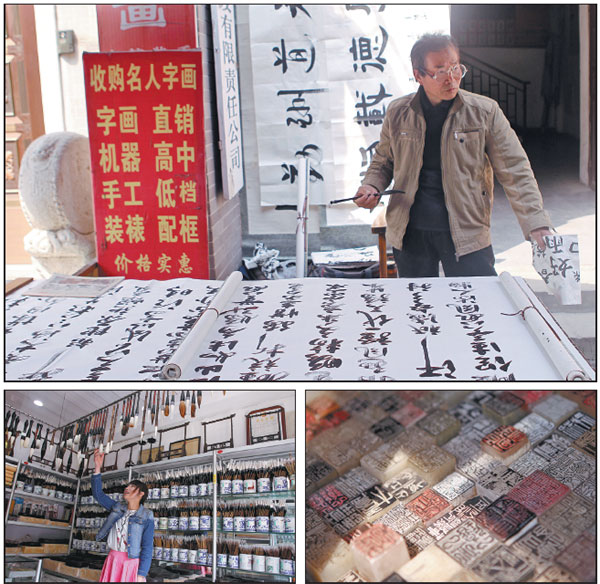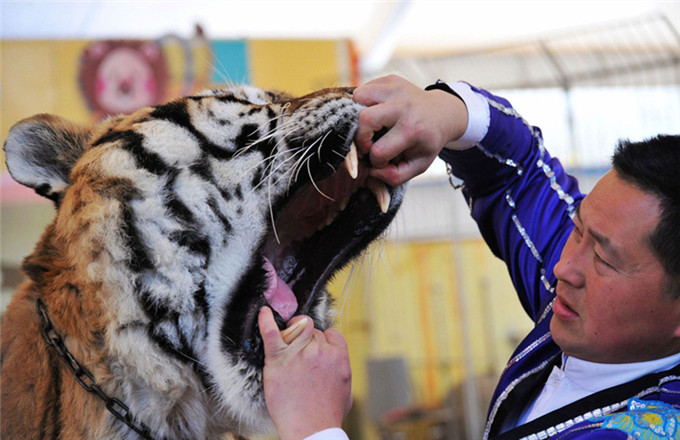Chinese calligraphy in touch-screen age
Debate rages over how much of traditional brushstroke writing will be inherited by a younger generation that uses technology to write
Zhou Qing holds a brush in one hand as she gestures with the other while talking to a potential customer at her shop in Shuyuanmen, where a network of streets behind a section of the Xi'an city wall, are lined with dozens of shops like hers that sell articles of Chinese calligraphy.
Xi'an, the capital of Northwest China's Shaanxi province, is one of the country's oldest cities. And Shuyuanmen, among the city's oldest areas, was likely a hub of cultural activities in imperial China - at least during the Ming (1368-1644) and Qing (1644-1911) dynasties.
As touch-screen devices increasingly take over China and handwriting becomes sparse in high schools and colleges, the fallout on calligraphy - if any, can be assessed here. While a few sellers of calligraphy materials say business is falling, some customers and scholars contest the idea of a big threat from technology to this ancient writing tradition.
"The younger generation uses computers, and that will affect Chinese calligraphy," says Zhou, 26, standing beneath brushes that hang from the ceiling of her family-owned shop. A thick or thin ink-dipped brush is used to make strokes of Chinese characters on special paper or cloth.
"There are very few students that come to buy these days," she says of her shop that has seen better days.
In a nearby store, a man who declines to give his name argues that technology alone isn't responsible for the perceived slowdown in sales of calligraphy tools. A native of eastern China's Jiangxi province, he has been selling brushes and paper in Shuyuanmen for the past 20 years, and calls this year tough for his trade. His goods cost from 10-1,000 yuan.
But there are other factors, including general market conditions and what calligraphy means to different age groups in China, he says. For the elderly, practicing calligraphy can be therapeutic and it can serve as a way to strengthen mental agility, the unnamed shop owner offers as an example.
Elsewhere in the neighborhood, Ma Xiaopeng, a 42-year-old calligraphy enthusiast is seen buying paper rolls rich in texture. Each roll has about 50 pages, with 4.5 yuan for one.
He describes calligraphy as a hobby that makes him relax, like yoga does. And while Ma no longer handwrites letters, he pursues Chinese calligraphy, he says.
Ma buys paper from a shop that is run by another East China native, who came to Xi'an from Anhui province, a few years ago. Besides paper, ink and brushes, this shop stocks up on a wide variety of trays made of rocks on which a calligrapher's ink is poured for the writing. The trays made of jade are more expensive.
One comes across several practitioners of calligraphy sitting in the open while walking through the lanes of Shuyuanmen.
Wang Minghu, the elderly deputy director of China Calligraphers Association, a Xi'an-based civil entity, is crouched over a big piece of white paper with a brush in hand. After submerging the brush in black ink contained in a pot on his table, Wang continues to write a poem by New China's founding father Mao Zedong, adjusting his glasses now and then.
Chinese calligraphy, which is more than 3,000 years old, is a vehicle of traditional culture, Wang says. "It will not be abandoned by future generations."
A museum of calligraphy that's located on one end of Shuyuanmen, draws many out-of-towners as evidenced on a weekday last month, seemingly underscoring Wang's opinion.
But the question remains: How much of the writing tradition will young Chinese likely inherit?
Zhao Xueqing, a veteran linguist from the city isn't too worried about the debate because schools in China still insist on children learning handwritten characters for the first six years of their education, at the least. The country's successive governments have also been active in preserving calligraphy, he says.
"Young people are doing OK," says Zhao, deputy dean, College of Chinese Language and Literature, Shaanxi Normal University.
|
Clockwise fromtop:WangMinghu completes a piece of writing in Shuyuanmen, Xi’an; seals in ancient Chinese language; Zhou Qing adjusts a calligraphy brush in her shop. Photos By Zouhong/ China Daily |



















